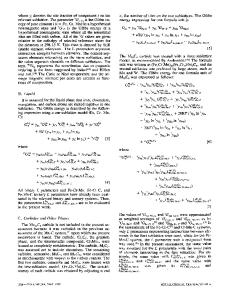Thermodynamic evaluation of the Cr-Ni-C system
- PDF / 866,361 Bytes
- 11 Pages / 594 x 774 pts Page_size
- 109 Downloads / 425 Views
I.
INTRODUCTION
NICKEL-base superalloys reinforced by chromiumcarbide precipitates have superior properties as heatresistant materials. In order to control the microstructure of such alloys, it would be of great value to have informarion on the phase equilibria at the service temperature. However, the commercial alloys usually have many components, and it is difficult to study the phase equilibria in sufficient detail. It may thus be useful to predict the phase equilibria of the higher-order multicomponent system by a thermodynamic calculation technique from information on the lower-order component systems. The ternary Cr-Ni-C system is one of the most important component systems for the nickel-base superalloys. In spite of this, there are few systematic investigations of the phase equilibria in this system. An estimation of its phase diagram was carded out by Ansara et al. tlj on the basis of the experimental results of the microstructure observations by K6ster and Kabermannt2J and of the carbon-activity measurements in the faee-eentered cubic (fce) nickel single-phase and fcc + M 7 C 3 two-phase regions by LSbl et al. t3] Recently, a larger amount of experimental information became available and was utilized in the present assessment. The Gibbs energies of formation of Cr23C6, Cr7C3, and Cr3C2 in the binary Cr-C system around 1300 K have been estimated by Andersson. t41 During the present assessment of the ternary Cr-Ni-C system, it was found to be impossible to get good agreement between the calculations and the experimental data without changing Andersson's thermodynamic parameters. In order to improve the agreement, a reassessment of the binary Cr-C system was carried out. The standard Gibbs energies of formation of these binary chromium carbides obtained recently by D u e t al. tSl by using an electromotive force (emf) technique, as well as the older experimental data used by Andersson, t4J were utilized in this reassessment. The thermodynamic parameters of the Cr-C and Cr-Ni-C systems were estimated simultaneously by using the
computerized optimization technique recently developed by Sundman et al.t6J and Jansson.tT] II.
THERMODYNAMIC MODELS
A thermodynamic model for phases with several sublattices has recently been developed.tS] In this model, the fraction of sites in each sublattice occupied by a component is described by the site fraction. The sum of site fractions in each sublattice is equal to unity by defmition. The model can also handle a contribution to the Gibbs energy due to magnetic ordering in the form suggested by Indentg] and Hillert and Jarl. tt~ The Curie or N6el temperature and the average magnetic moment per atom are entered as functions of the composition. A. Fcc and Bcc
The Gibbs energy for the nickel-rich fcc and chromiumrich body-centered cubic (bcc) phases in the ternary Cr-Ni-C system can be described with a two-sublattiee model. It was assumed that nickel and chromium can substitute for each other on a metal sublattice and carbon and vacancies on an interstitial sublattice. The
Data Loading...











